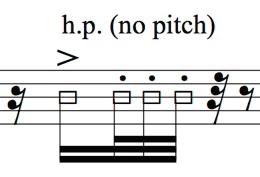LEWIS
Weathering for orchestra
Full Score


Full Score

Commissioned by the American Composers Orchestra with the support of Elizabeth and Justus Schlichting.
L E I P ZI G · L ONDO N · NE W YOR K
Instrumentation
Flute I in C, doubling Piccolo in C
Flute II in C, doubling Piccolo in C
Oboe I
Oboe II
Clarinet I in B-Flat
Clarinet II in B-Flat
Bassoon I
Bassoon II, doubling Contrabassoon
Horn I in F (mutes: straight)
Horn II in F (mutes: straight)
Trumpet I in C (mutes: straight, harmon with stem, plunger)
Trumpet II in C (mutes: straight, harmon with stem, plunger)
Trombone (mutes: straight, harmon with stem, plunger)
Tuba (mutes: straight)
Harp
Piano
Timpani
Percussion I
Snare Drum Medium Tom-tom Concert Bass Drum Large Cymbal Medium Cymbal Medium Tam-tam Brake Drum Xylophone 4 Bossed Gongs (A4, C5, Eb5, G5)
Percussion II
High and Low Bongos High Tom-tom Floor Tom Large Sizzle Cymbal Large Tam-tam Brake Drum Castanets (hand) 4 Bossed Gongs (Ab4, Bb4, Db5, Gb5)
General: Bow, sticks, mallets, brushes, Superball beaters, chopsticks, etc.
Percussion I

Violin I
Violin II
Viola
Cello
Contrabass
Symbols
s.t.: sul tasto (arco)
s.p.: sul ponticello (arco), normal pressure
c.l.b.: col legno battuto
Percussion II

m.s.t., a.s.t.: molto sul tasto (arco)
m.s.p., a.s.p.: molto sul ponticello (arco)
m.p.: moderate bow pressure (some pitch)
h.p.: heavy bow pressure (some pitch) bisb.: bisbigliando (in winds, timbre trill)
+ = closed plunger or harmon mute o= open plunger or harmon mute
m.v.,m.m.v.: molto (molto) vibrato (normal speed, widest pitch range possible)
square or open noteheads: indicates air sound, growls, or other production of indefinite pitch

h.p.: heavy pressure (with some pitch, using approximate indicated pitches)

h.p. (no pitch): heaviest, pure noise (staff position not indicative of pitch level)

, multi, multiph: stable, dissonant multiphonic sound on given note

Indefinite pitches in indicated register

Box notation: V = create Versions of immediately preceding passage

Bow pressure specification (relative): high low

Vibrato: Should match the duration of the first note to which they are attached. Speed is similar to normal vibrato, but pitch range is much wider, similar to Korean nonghyeon






very wide narrow accented fading growing “jeonseong” (grace note-like rise and fall in pitch)



glissando down with vibrato glissando up with vibrato accented vibrato
General performance notes
voice grunt, growl (winds): Use rough-textured voice and play at the same time. slap tongue: Produce percussive sounds with some pitch content, which may be indeterminate in pitch
In brass, the technique is analogous to the flutist’s tongue ram.
air sound (winds): Sharp, hissy breath textures are intended.
glissandi:
Short, leading toward an attack: Treated like sliding grace notes. Short, trailing a note: Analogous to a short verbal shout. Long, trailing a note: Should not exceed the total duration of the note. Follow approximate pitch curve.
Between notes: Follow approximate pitch curve.
The score is transposed, in the customary way:
Piccolo sounds an octave higher than written
B-Flat Clarinet sounds a major 2nd lower than written Contrabasoonsounds one octave lower than written
Horn sounds a perfect 5th lower than written Contrabass sounds an octave lower than written
Specifications as to instruments, bowings, mutes, articulations, etc., are maintained until superseded by a subsequent specification, or by the “ord.” instruction. Accidentals carry through the measure. Trills are always half-step, and are executed with irregular speed, as with tremolos. Specified vibratois always irregular, unstable, and non-synchronized.
Duration: 17minutes

George Lewis (b. 1952) is Professor of American Music at Columbia University and Area Chair in Composition. He is a Fellow of the American Academy of Arts and Sciences and the American Academy of Arts and Letters, and a Corresponding Fellow of the British Academy. His other honors include a MacArthur Fellowship (2002) and a Guggenheim Fellowship (2015). A member of the Association for the Advancement of Creative Musicians (AACM) since 1971, Lewis’s work has been documented in more than 150 recordings and has been presented by the BBC Scottish Symphony Orchestra, Ensemble Dal Niente, the London Philharmonia Orchestra, International Contemporary Ensemble, Ensemble Musikfabrik, Mivos Quartet, Spektral Quartet, London Sinfonietta, and others. Lewis holds honorary degrees from the University of Edinburgh, New College of Florida, and Harvard University.
George Lewis (*1952) ist Professor für amerikanische Musik an der Columbia University and Leiter des Fachbereichs Komposition. Er ist Mitglied der American Academy of Arts and Sciences und der American Academy of Arts and Letters sowie korrespondierendes Mitglied der British Academy. Zu weiteren Auszeichnungen zählen ein MacArthur-Stipendium (2002) sowie ein Guggenheim-Stipendium (2015). Seit 1971 ist er Mitglied der Association for the Advancement of Creative Musicians (AACM). Lewis’ Musik ist in über 150 Aufnahmen dokumentiert und wurde u. a. vom BBC Scottish Symphony Orchestra, Ensemble Dal Niente, London Philharmonia Orchestra, International Contemporary Ensemble, Ensemble Musikfabrik, Mivos Quartet, Spektral Quartet und von der London Sinfonietta aufgeführt. Er ist Ehrendoktor der University of Edinburgh, des New College of Florida und der Harvard University.